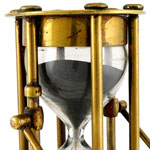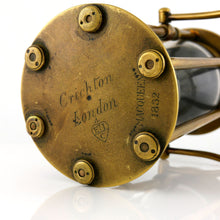East India Company Maritime Service - A Watch Sandglass, 1832
Adding product to your cart
Height: 18.5cm (7.25in)
Brass frame holding the glass timer filled tin filings; one end engraved with the maker’s name ‘Crichton / London’, over the East India Company’s ‘Sign of Four’ trademark, and name and date, ‘MacQueen’ / 1832’, for the Honourable Company’s Ship Macqueen (1333 tons).
Read more
By the early 19th century sand glasses or those filled with lead or tin filings were used on ships to measure watch times, typically in half-hour periods. Traditionally the helmsman was responsible for turning the glass, thus supplying the time to be registered on the ship's log. Watch measurement began at midday when the ship's bell was struck eight times. After the first glass had emptied (half an hour), the ship's bell was struck once, after another glass, twice, and so on until four hours after midday, when it was again struck eight times. At that point, a new watch began, and the sequence was repeated. The present glass was made by John Crichton (fl.1831 and 1865) of Leadenhall Street, London whose premises were located close to the Honourable Company’s headquarters, East India House.
The East Indiaman MacQueen was built at the Quarry House shipyard opposite Chatham in 1821. She was 166ft long and made at least six year long voyages to Bengal and China. For the greater part of her career she was commanded by Captain James Walker who during the voyage of 1828 was embroiled in a long running dispute with the commanding officer of the 41st (Welch) Regiment of Foot, Lt-Col. Sir E.K. Williams. Walker and the Welshman exchanged insults all the way to the East and finally aired their differences at a court-martial. In 1832 Macqueen sailed from the Downs commanded by Captain Robert Lindsay on the year long voyage to China which was reached on 31 March 1833. The East Indiaman was also the subject of an engraving published in 1834 after the maritime painter William John Huggins (1781-1845), who was himself a former sailor in the East India Company’s Maritime Service.






